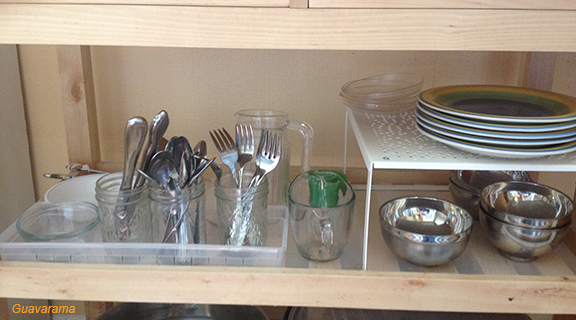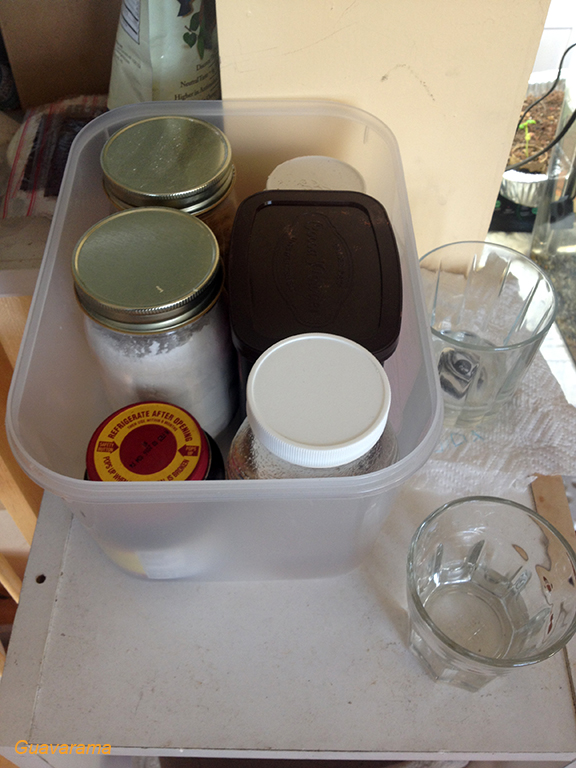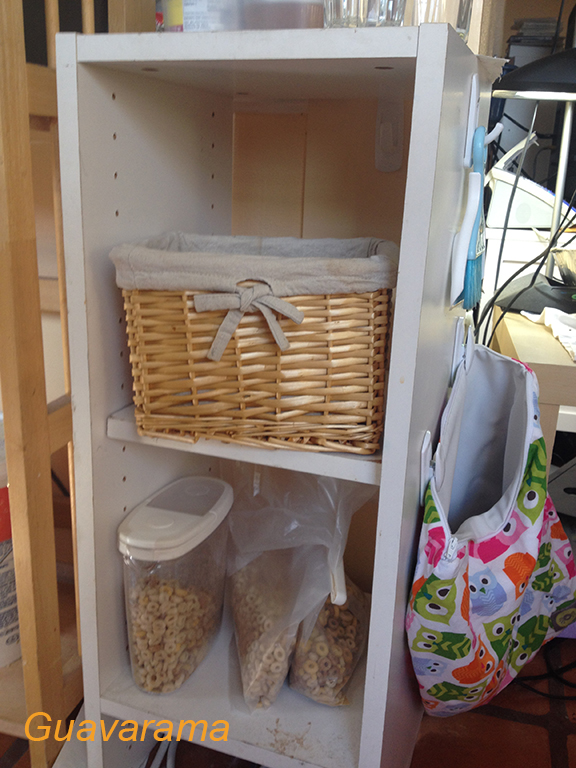Before Astroboy was born, I used to get very frustrated at the fact that Practical Life with Thumper was not what I’d read in books. (I had a lot of misguided ideas.) Weren’t kids supposed to be mopping the table at 2 or 3? (Note the word “supposed”.) By the time Astroboy arrived, I’d figured out a few things. Given that I’m kind of messy and a bit lazy by nature, we did not really have a proper environment set up for the kids to consistently do it.
If you read Montessori from the Start, the author Lillard talks about creating a child-friendly, child-sized environment for your baby. Floor on the bed, hanging mobile, only a few toys in baskets on the floor, a place for the children to get their own clothing that is limited to about 2-3 choices, their own low table and small chair to eat. I was so sleep deprived, I just never got around to it except the floor on the bed. We had an Ikea child-sized table. But Astroboy seldom ate there because his sister was old enough to sit at the table with us.
I ended up doing what I like to call “half-ass hearted” practical life. I let go of the other things I’m supposed to have. We started with a utensil area in the kitchen for the children and eventually added a water area for the children, a small mirror above the sink, and most recently snack serving stations. Whenever I got around to it, which was usually a year later than I started wanting it, I set them up. E
These are things any family can add to their kitchen setup. They don’t have to attempt more than that, but the other things kind of naturally follow. Even if you don’t follow Montessori philosophy, having these stations setup will probably makes your life so much easier in the long run.
Practical Life?
Practical Life in Montessori is just things that are daily life skills. She talked in her book about how appreciative one school child was to be finally shown how to blow his own nose so he doesn’t have to have someone else do it. It’s setting up an environment, and showing the children how to care for themselves.
You can do Practical Life in a half ass hearted way by just following the rule of put things the children use at their level. Practical Life is not there really to make my life easier, even though that is why I’m drawn to it. In our album, the aim of Practical Life is order, concentration, coordination, and independence. It isn’t necessarily: “learn how to fold laundry”, or “learn how to set the table”. It’s there to empower the children and answer their cry of “Me do it!” To help with these 4 aims, I try (though fail often) to add two more things to the “presentation”. One is how to get the material out, and the other is to how to return them. For example, to teach the children to do laundry, the important part isn’t to show them how to push the buttons. It’s the 3 step process of showing them how to put the laundry in the washer, how to start the load, and how to get that laundry out. Following a sequence of actions is a great preparation for kindergarten.
Our Practical Life environment

The serving area in our kitchen has some breakable plates, non-breakable Korean type bowls, some small pitchers and bowls, and utensils. When Astroboy was young, the nanny was the one who had to shoo him away when he was in the “likes to drop things” phase. His personality meant that he would watch you if you gave him a proper demonstration of how to carry things, so that phase did not last too long. I find that kids may hold breakable items in a way that gives you a heart attack and say, “Noooooooooo! Be careful!” But more often than not they will not break them. It does require an eagle eye and supervision for maybe 1-2 years, when they’re acquiring their motor skills as a young toddler. And trust.
Do things break? Yes. So many glass cups have broken in our house. That’s why we just buy the Ikea ones. Using metal bowls or plastic bowls definitely makes life much easier. But after the umpteenth times, it doesn’t phase me anymore, or get me mad. I have come to accept that children will break things or spill things, or drop food on the floor. The adults will sweep up the glass when they break. But I will point them to the mop or the broom when they spill food or water and say, “沒關係,擦一擦就好了. It’s okay, let’s mop it up.” . My anger comes partly because the children has now made a mess that I have to clean up. When the responsibility is shifted to the person who made the mess, I feel so much better.
I didn’t do all plastic because if I did want them to understand that they need to be careful when handling these items. And it is hard to teach them that if they don’t experience something breaking. I distinctly remember 2 times with Thumper. Once I’d told her to not play with her glass cups in the bathroom. She insisted and it broke. I still remember the shocked and contrite look on her face. Another time I kept telling her to be careful with the glass milk jug. That it is too big for her. She insisted on carrying it. She dropped it on the way to the fridge. We spilled milk all over the floor and it required a lot of adult mopping milk in crevices. She was always careful after that.
When I’m not feeling lazy, I pour our milk into the Ikea small jug you see in the pic. The children can then get and pour their own milk. I think by the time Astroboy was 2.5/3? he was getting his own utensils and getting himself water.
Because I had such a hard time with Thumper when she was 4 to get her to set the table and clean up, I started all of these things way younger with Astroboy. Really children are most receptive of doing it themselves between ages 1-3, as it when they’re working on their gross motor skills. Because once they master a skill, they’re not as motivated to actually doing it.

You can do those Arrowhead water dispensers. I just have a thing with plastic. It took me awhile to find this at Target. Or was it Bed Bath and Beyond? We started with the small Ikea glasses for Astroboy when he was learning how to hold a glass and learning how to drink. But we graduated to the bigger Ikea glasses. I love these Ikea glass because it is faceted so you can point to the middle of the glass and tell the child to only fill up the water to there. In the Montessori classroom sometimes they use a blue masking tape to show where to fill the glass to. But as I said, I’m a lazy mom. I also have those Korean glass just to save myself on having to watch the kids all the time. I forgot to mention, like the bowls, they are insulated so you don’t have to worry about kids burning themselves.
When kids see a new gadget they will want to play with it. With us, after after 1-2 weeks of wanting to constantly open and close the water spout, the kids stopped treating it like a toy and used it as a tool.

Too lazy to take a pic of the mirror above the sink. I found a small 4 inch by 3 inch mirror in a stand at Daiso, took the mirror out and glued it above the sink. Once you have that mirror, I was able to teach Astroboy to wash his face and brush his teeth. It’s really hard to tell them what to do. Much easier to tell them, “Go look at yourself in the mirror and wash your face.”
About half a year ago, I had a brain fart and said, “Why am I constantly getting honey, cereal, and hot chocolate for the children? They can get it themselves!” So I set up a station with food they frequently use, plus a basket of old bibs to serve as napkins. This is how Thumper and Astroboy is able to make their own hot chocolate in the morning. We started with the kids only prepping the mix and I cook the milk and pour it. But in the last 2 months Thumper is able to make it herself.

The kids also now pour their own cereal. I’m still looking for that perfect container for cereal that the kids can use without myself. These Ikea containers are hard to open and the lid doesn’t stay open when you pour.

Lastly, a monthly ago, we got a similar shelf used because I was running out of space to hold food items. Now that the children are making their own breakfast and lunch, I’d been meaning to put those things somewhere they can reach. Otherwise they are constantly getting a chair to open cupboards. We now have a new shelf for snacks and food like cream of wheat, mac and cheese. The child-size cheese grater should be in there, along with things they use to cook or set the table. Plus extra cereal boxes. This one has a door so ideally not something they would reach for daily, unlike the other food station.
Practical Life and Chinese
Now that I’m more concentrating on speaking and listening skills, it occurred to me recently that Practical Life is a good way to teach language. It’s not really about the set up I detailed here, but when the kids are doing Practical Life, they hear daily speech and also enrich their vocabulary. For example, how often will they encounter the words you use to make bread in a textbook; rolling, kneading, rising, punching down, etc. Practical Life provides a good introduction to vocabulary with a concrete experience. I’m now thinking of ways I can extend past it and introduce the terms in class in a more formal way.
Thanks for the sharing. It encourages me to make a kids practical kitchen environment early for my 1yr old girl. She likes to open all the kitchen cabinets recently. My 4 yrs old girl started doing kitchen works from her 1.75 or 2 yrs old.
About the cereal container, we use OXO Pet Pop Container, Big Square, 2.4-Liter(http://amzn.to/1SsxPUz). It’s very easy to secure and open by kids. You can check it out.